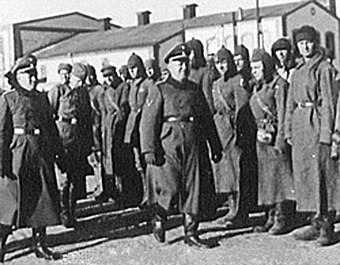Our website is made possible by displaying online advertisements to our visitors.
Please consider supporting us by disabling your ad blocker.
Trawniki men
| Trawnikimänner | |
|---|---|
 Inspection of Trawnikimänner (some of them still wearing Soviet Budenovkas) by SS-Hauptsturmführer Karl Streibel (center) at the SS Trawniki training division. As Hiwis, they were tasked with liquidating Nazi-era Jewish ghettos in occupied Poland | |
| Active | Founded in 1941 |
| Country | German-occupied Poland |
| Allegiance | |
| Branch | |
| Type | Paramilitary police reserve |
| Role | Logistical support for Order Police battalions and the SS during Operation Reinhard; shooting actions, deportations to death camps |
| Size | Over 5,000 Hiwis |
During World War II, Trawniki men ([travˈniki]; German: Trawnikimänner) were Eastern European Nazi collaborators, consisting of either volunteers or recruits from prisoner-of-war camps set up by Nazi Germany for Soviet Red Army soldiers captured in the border regions during Operation Barbarossa launched in June 1941. Thousands of these volunteers served in the General Government territory of German-occupied Poland until the end of World War II. Trawnikis belonged to a category of Hiwis (German abbreviation for Hilfswilliger, literally "those willing to help"), Nazi auxiliary forces recruited from native subjects serving in various jobs such as concentration camp guards.[1][2]
Between September 1941 and September 1942, the German SS and police trained 2,500 Trawniki men known as Hiwi Wachmänner (guards) at the special training camp at Trawniki outside of Lublin; by the end of 1944, 5,082 men were on active duty.[1] Trawnikimänner were organized by Streibel into two SS Sonderdienst battalions. Some 1,000 Hiwis are known to have run away during field operations.[3]: 366 Although the majority of Trawniki men or Hiwis came from among the prisoners of war, there were also Volksdeutsche from Eastern Europe among them,[4][5] valued because of their ability to speak Russian, Ukrainian and other languages of the occupied territories. All the officers at the Trawniki camp were Reichsdeutsche (citizens of the German Reich), and most of the squad commanders were Volksdeutsche (people whose language and culture had German origins but who did not hold German citizenship).[5] The conscripted civilians and former Soviet POWs included Armenians, Azerbaijanis, Belarusians, Estonians, Georgians, Latvians, Lithuanians, Russians, Tatars, and Ukrainians.[6] The Trawnikis took a major part in Operation Reinhard, the Nazi plan to exterminate Jews. They also served at extermination camps and played an important role in the annihilation of the Warsaw Ghetto Uprising (see the Stroop Report), among others.
- ^ a b Cite error: The named reference
USHMM1was invoked but never defined (see the help page). - ^ Browning 1998, p. 52.
- ^ David Bankir, ed. (2006). Police Auxiliaries for Operation Reinhard by Peter R. Black (Google Books). Enigma Books. pp. 331–348. ISBN 192963160X. Retrieved July 12, 2014.
{{cite book}}:|work=ignored (help) - ^ Gregory Procknow (2011). Recruiting and Training Genocidal Soldiers. Francis & Bernard Publishing. p. 35. ISBN 978-0986837401..
- ^ a b Yitzhak Arad (1987). Belzec, Sobibor, Treblinka: The Operation Reinhard Death Camps. Indiana University Press. p. 21. ISBN 0253342937.
- ^ Cite error: The named reference
Kudryashov, Sergei pages 226-239was invoked but never defined (see the help page).
Previous Page Next Page


